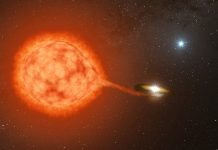
Dark matter, a mysterious and invisible substance thought to make up about 85% of the universe’s matter, has long puzzled scientists.
Unlike regular matter, which we can see and feel, dark matter doesn’t emit, absorb, or reflect light, making it extremely difficult to detect.
However, a new theory called “self-interacting dark matter” (SIDM) is offering exciting explanations for some longstanding cosmic puzzles.
Hai-Bo Yu, a professor of physics and astronomy at the University of California, Riverside, along with his team, has published a study in The Astrophysical Journal Letters that could change how we understand dark matter.
Their research suggests that SIDM could be the key to understanding two major astrophysical mysteries.
Firstly, the team looked at the dark matter halo of a massive elliptical galaxy, detected through the phenomenon of strong gravitational lensing. Gravitational lensing happens when light from distant galaxies bends around massive objects, acting like a cosmic magnifying glass.
The density of this halo was surprisingly high, which didn’t fit with the traditional theory of cold dark matter (CDM). According to CDM, dark matter particles don’t interact with each other.
Secondly, they explored the ultra-diffuse galaxies, which are galaxies with extremely low brightness and widely spread-out stars and gas. These galaxies have dark matter halos with very low densities, another puzzle that CDM struggles to explain.
So, what makes SIDM different? SIDM proposes that dark matter particles can interact with each other through a “dark force.” This means they can collide, especially near the center of a galaxy, leading to diverse densities in the dark matter halos.
To test this theory, Yu and his colleagues, including Ethan Nadler and Daneng Yang, conducted sophisticated computer simulations of how cosmic structures form with strong dark matter self-interactions. These simulations showed that SIDM could lead to varying densities in the central regions of galaxies. Some halos would have higher densities, while others would have lower densities, depending on their cosmic history and environment.
This finding is significant because it challenges the standard CDM model, which has been the prevailing theory for understanding dark matter. The SIDM theory suggests that dark matter might be more complex and dynamic than previously thought.
The research underscores the importance of using astrophysical observations and computer simulations to study dark matter. With upcoming data from powerful telescopes like the James Webb Space Telescope and the Rubin Observatory, there’s potential for even more discoveries in this exciting area of research.
Yu’s work, which has been gaining traction since around 2009, is pushing the boundaries of what we know about dark matter.
By suggesting that dark matter particles interact with each other, SIDM is offering new ways to solve cosmic mysteries and is enriching our understanding of the universe’s most elusive substance.



